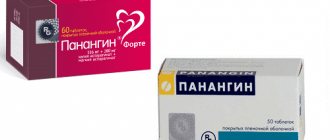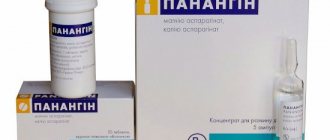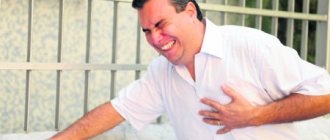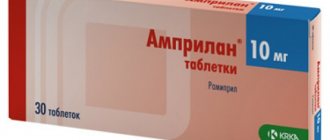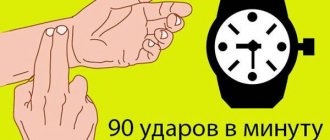For the treatment of patients with coronary heart disease, the French company Servier produces a drug based on trimetazidine - Preductal. It belongs to a new group of medications that can act directly on myocardial cells experiencing oxygen starvation. Patients note a significant improvement in quality of life, which is manifested in a decrease in angina attacks and better tolerance to physical activity.
Why PREDUCTAL® MR is the most prescribed cardiac drug by doctors
| What does the new concept of treatment of coronary heart disease (CHD) offer to patients with angina pectoris? New guidelines for the treatment of angina pectoris, adopted in 2006 at the last World Congress of Cardiology, recommend the use of metabolically active drugs to reduce angina attacks, improve exercise tolerance and improve the quality of life of patients with coronary artery disease. |
Traditional approaches to treating patients with coronary artery disease are aimed at improving oxygen delivery to myocardial cells and reducing their need for it. β-adrenergic receptor blockers, calcium antagonists and nitrates have an antianginal effect by changing hemodynamic parameters (strength and frequency of heart contractions, improving coronary blood flow, reducing pre- and afterload on the heart, etc.). Despite the wide selection of these drugs, monotherapy with them often does not provide sufficient treatment effectiveness, since these drugs only indirectly affect the oxygen supply of the myocardium. On the other hand, the results of numerous studies (TIBET, IMAGE, CESAR, etc.) have shown that the combination of β-adrenergic receptor blockers, calcium antagonists and nitrates does not provide a significant additional reduction in the frequency and severity of angina pectoris. This significantly increases the risk of developing side effects such as bradycardia, arrhythmia, hypotension, etc. In the treatment of coronary artery disease, it is necessary to clearly determine the point of application of the drug used and the possibility of its use in different groups of patients. Over the past few decades, numerous attempts have been made to create drugs that effectively act directly on ischemic cardiomyocytes. The efforts of scientists were concentrated on the final link in the pathogenetic chain of ischemia—the disruption of oxidative processes at the cellular level. This direction is called cytoprotective, or metabolic.
The modern concept of treatment of IHD involves the use of metabolic drugs with a pronounced antianginal effect. It is very important that the metabolic approach is based on evidence-based medicine, that is, metabolic drugs with proven antianginal effectiveness and a studied mechanism of action are prescribed. The effectiveness of such a drug must be confirmed by clinical studies, and clear evidence of its antianginal effect in patients with coronary artery disease is needed.
PREDUCTAL ® MR (modified release trimetazidine tablets) - original development (France) - a representative of a new group of antianginal drugs with a metabolic mechanism of action. The drug has proven itself well in the treatment of patients with angina pectoris, especially when the effectiveness of monotherapy with hemodynamic agents was insufficient (Makolkin V.I., Osadchiy K.K., 2004). PREDUCTAL ® MR today is the only metabolic drug presented on the pharmaceutical market of Ukraine with a studied mechanism of action and proven antianginal effectiveness. It is included in the latest European guidelines for the treatment of stable angina (2006) and recommended by the Ukrainian Society of Cardiology for the treatment of coronary artery disease.
The action of PREDUCTAL MR is based on a direct effect on metabolic processes in cardiomyocytes. As is known, impaired blood supply to the heart during ischemia is a trigger point in the development of metabolic disorders that lead to impaired myocardial function. A person feels these changes as pain in the heart. The continuous functioning of the heart requires a constant and reliable supply of energy. Glucose and free fatty acids are the two main types of substrates that the heart muscle, like many other tissues of the body, uses to synthesize ATP. In normal cardiac activity, cardiomyocytes preferentially use fatty acids, and at increased functional load, when it is necessary to accelerate the process of ATP synthesis, glucose is used. Fatty acids are a less “efficient” source of energy compared to glucose, since they need 10% more oxygen to form an equivalent amount of ATP (Kapelko V.I., 2000; Shakhnovich R.M., 2001). During hypoxia, free fatty acids accumulate in the myocardium, inhibiting glycolysis (oxidative phosphorylation of glucose), which leads to a decrease in the formation of ATP, weakening of myocardial contractility, and damage to cell membranes.
The action of PREDUCTAL MR is based on a direct effect on metabolic processes in the myocardium. The drug acts at the cellular level, selectively inhibiting a key enzyme in the β-oxidation chain of fatty acids and thereby activating a more efficient and economical process of glucose oxidation. Thus, the metabolic effects of PREDUCTAL MR are due to the normalization of energy metabolism in the myocardium and the “switching” of cardiac metabolism to the most advantageous path in order to maximize energy production under conditions of ischemia and prevent further disorders of myocardial metabolism. This “switching” of energy metabolism leads to increased ATP synthesis in cardiomyocytes, reduces tissue acidosis that occurs during ischemia, and maintains myocardial contractile function (Kantor PF et al., 2000). While taking the drug PREDUCTAL ® MR, phospholipid metabolism also increases, which ensures protection of cell membranes from damage and a protective effect on cardiomyocytes. These positive effects of PREDUCTAL ® MR are in no way related to changes in the balance between coronary perfusion and myocardial oxygen demand and do not affect heart rate or blood pressure (Belardinelli R. et al., 2001). Therefore, the use of PREDUCTAL MR, a metabolic antianginal drug officially recommended by the new European Society of Cardiology guidelines for the treatment of angina (2006), is necessary.
Side effects
In most cases, the drug is well tolerated by patients. Gradation of the following side effects: very common - 1/10, uncommon - 1/1000, but not more than 1/100, rare - 1/10,000, but not more than 1/1000, isolated - ≤1/10,000, frequent - 1 /100, but not more than 1/10.
Gastrointestinal tract: diarrhea, pain in the epigastric region, nausea and/or vomiting, dyspeptic symptoms (often).
Nervous system: dizziness and headache (frequent); extrapyramidal symptoms, especially with concomitant Parkinson's disease - muscle rigidity, akinesia, tremor (in isolated cases, relieved by drug withdrawal).
Skin and skin appendages: itching, rash, urticaria (frequent), facial skin flushing (rare).
Cardiovascular system: orthostatic hypotension (rare).
Other: asthenia (often).
Preductal for cardiac arrhythmia
Ventricular heart rhythm disturbances are the leading predictors of sudden arrhythmic death and therefore quite reasonably require active treatment (Belousov Yu.B., 2000; Mazur N.A. et al., 2003; Sulimov V.A., 2004). The results of the CAST trial, completed in 1989, and other studies that followed it, demonstrated that most antiarrhythmic drugs (Class IA, IB, IC, β-blockers with adrenomimetic activity, slow calcium channel blockers) may increase the risk of sudden death when used their patients after myocardial infarction and/or left ventricular systolic dysfunction (Golitsyn S.P., 2002). β-blockers without adrenomimetic activity and class III drugs (amiodarone, sotalol) demonstrated relative safety.
One of the methods for improving antiarrhythmic therapy may be the inclusion in the treatment regimen of drugs that improve the metabolism of cardiomyocytes. Pathogenetically, this seems quite reasonable, since the occurrence of arrhythmias is caused by a change in the electrophysiological properties of the cell membrane against the background of a pathological process in the myocardium (Vakhlyaev V.D. et al., 2000). Therefore, the use of agents that have a membrane-protective effect may increase the effectiveness and safety of antiarrhythmic drugs. The Russian Pharmacocommittee has authorized the use of drugs such as emoxipine and preductal for chronic coronary heart disease as drugs that improve myocardial metabolism. However, it remains unclear how advisable the use of metabolic agents is in patients with coronary artery disease complicated by cardiac arrhythmias.
Purpose: to study the effect of emoxipine and preductal on the effectiveness of treatment of ventricular arrhythmias in patients with coronary artery disease.
Materials and methods
The study included 45 patients with chronic forms of coronary artery disease (25 men and 20 women) aged from 42 to 73 years, the average age of those examined was 52±1.2 years. All patients had rhythm disturbances in the form of frequent, paired or other prognostically unfavorable ventricular extrasystole. In some patients, during the initial examination, supraventricular extrasystoles, paroxysms of supraventricular tachycardia, and atrial fibrillation were also recorded.
The following parameters were studied:
- According to daily ECG monitoring: minimum and maximum heart rate, ventricular and supraventricular arrhythmias.
- Biochemical blood parameters: total cholesterol, AlT, AST.
- ECHO-CG results: end-systolic and end-diastolic dimensions, ejection fraction.
- QT interval variance.
For all patients, the listed indicators were recorded upon admission to the hospital to diagnose the type of heart rhythm disturbances and select for further observation. If necessary, adjustments were made to conventional therapy for ischemic heart disease, including nitrates, ACE inhibitors, dihydropyridine calcium antagonists, and antiplatelet agents. In order to relieve ventricular arrhythmias, one of the antiarrhythmic drugs was prescribed. The following antiarrhythmics were used: atenolol (100 mg/day, n=11), etacizine (150 mg/day, n=7), allapinin (75 mg/day, n=11), cordarone (600 mg/day, n= 10), rhythmonorm (300 mg/day, n=3), verapamil (240 mg/day, n=3). All antiarrhythmic drugs except cordarone were prescribed to patients for 5 days. Cordarone, given its pharmacokinetics, was prescribed for a longer period. On average, 10-12 days before the appearance of signs of saturation (decrease in heart rate less than 60 per minute or prolongation of the QT interval on the ECG. Patients with persistent ventricular rhythm disturbances were additionally prescribed preductal in a daily dose of 60 mg orally or emoxipine in a daily dose of 60 mg intravenously to the received therapy A control study was carried out after 5 days of combined use of an antiarrhythmic drug with a metabolic drug.
Statistical processing of the research results was carried out using the statistical software package Excel 2002. Mathematical processing included calculations of arithmetic means (M), their errors (m), the reliability of differences in arithmetic means (p) using Student's t-test, as well as the criterion.
Results and discussion
Most AAPs have a negative chronotropic effect. For tachyarrhythmias, such an influence is necessary, but if rhythm disturbances occur against the background of normal or reduced automatism of the sinus node, the use of AAP may worsen the course of the disease.
Preductal, unlike emoxipine, significantly increases the minimum heart rate in combination with atenolol and cordarone, i.e. weakens the negative chronotropic effect of these antiarrhythmics. Metabolic agents do not alter the effect of AAP on maximum heart rate.
When using preductal and emoxipine in combination with etacizin and allapinin, no influence of metabolic agents on the chronotropic effect of antiarrhythmics was detected, either in terms of the minimum or maximum heart rate.
Supraventricular cardiac arrhythmias (SVHD) are an independent factor increasing the risk of death in various categories of cardiac patients. They were registered in all groups of patients. Objective criteria for the antiarrhythmic activity of drugs were considered to be both an absolute decrease in the number of supraventricular SVCs and the number of patients in whom a decrease in the number of supraventricular extrasystoles (SVEs) was recorded by 70% or more compared to the initial level.
The study revealed the potentiating effect of emoxipine on the antiarrhythmic activity of all studied drugs in case of EVE, mostly cordarone and allapinin. Preductal enhanced the antiarrhythmic activity of only cordarone and allapinin. No significant difference in the effect of emoxipine and preductal on the activity of AAP was detected (Table 1).
Table 1. Antiarrhythmic effect of AAP and their combinations with metabolic agents for supraventricular extrasystole
Number of patients with NVE
Number of patients with 70% antiarrhythmic effect
Source: fundamental-research.ru
Causes, diagnosis and treatment of paroxysmal tachycardia
A low pulse with high blood pressure, the causes of which lie in a malfunction of both the vascular system and the functioning of the heart, is a very dangerous condition if it is stable. When the rhythm occasionally slows down to 60 beats or lower in combination with a jump in blood pressure, you need to carefully monitor heartbeat parameters and vascular tone in the future - this is a typical picture of bradycardia. If there is a strong, even one-time, drop in heart rate (below 30 beats), emergency assistance is required.
Blood pressure exceeding the upper limit of 140 mm Hg. Art. and lower 90 mm Hg. Art., is elevated. Constant values exceeding this limit allow the diagnosis of hypertension, hypertension.
We suggest you read: Tachycardia, sinus tachycardia in a 10-year-old child
If a similar condition, when a rare pulse is observed with high blood pressure, often recurs, you need to understand the reasons, go to a cardiologist, and get examined. A severe slowdown in the pulse threatens a lack of blood supply to organs and tissues, fainting, and death.
The blood vessels are caused by heart contractions when a portion of blood is released into the bloodstream at the time of the next shock. The pulsation frequency of the vascular walls reflects the rhythm of the heart - the faster it is, the higher the pulse. Heart rate (HR) is a diagnostic parameter.
Various factors influence heart rate:
- Age;
- Loads;
- Ambient temperature;
- Physical condition of the body;
- Volume of the heart chambers;
- Myocardial function;
- Condition of the atria, ventricles, valves;
- Tone of the aorta and blood vessels;
- Psycho-emotional impact;
- The effect of certain substances - nicotine, caffeine, a number of medications;
- Infections;
- Hormonal factor.
Calculate the pulse by pressing 3 fingers to the inside of the wrist. The count is kept for 15 seconds, the result obtained is multiplied by 4. In case of arrhythmia, when the beats are not uniform, it is better to wait a full minute. The second option is to feel the pulsation of the carotid artery in the neck and calculate in the same way.
The physiological norm for infants up to 3 months is considered to be from 100 to 150 beats per minute, from 3 to 6 months - from 90 to 120, from six months to a year - from 80 to 120. In children from one year to 10 years of age, the normal rate is from 70 to 130 beats per minute. After 10 years, at any age, a speed of 60 to 100 beats is acceptable, except for athletes. Due to their training and increased volume of the heart chambers, the norm is considered to be from 40 to 60 beats.
For an ordinary person, including older people, a rhythm below 60 beats is considered low, and less than 30 beats is considered dangerous. In combination with high blood pressure, a slow heartbeat threatens cardiac arrest.
Cardiac shocks do not directly affect the vascular lumen. Regulators of the sympathetic and parasympathetic systems are responsible for tone. If the vessels are compressed, either the force of the push or the frequency of contractions decreases. Therefore, for hypertension, a picture of a decreased rhythm is not uncommon.
For our body, the priority is the brain, its blood supply, oxygen supply. Elevated blood pressure may increase intracranial pressure. To normalize it, a compensatory factor is activated - the vagus nerve, which, when activated, causes the heart to slow down so that the brain tissue is not damaged. When the pressure decreases, the vagus nerve calms down, and the pulse returns to normal levels.
Indicators of blood pressure and heart rate are not directly interrelated with each other, only indirectly and in some cases. It is not necessary that the heart will “freeze” at high pressure, and vice versa - when the blood vessels relax, the rhythm will not always increase.
If blood pressure is often elevated and pulse is low, this condition should alert the person; it cannot be considered normal. A full examination will reveal the cause of abnormalities in the myocardium, vascular tone, disruption of the heart, and endocrine glands.
Most often, this combination of high blood pressure and slow rhythm is provoked by:
- Vegetovascular dystonia (VSD);
- Jump in cerebral pressure;
- Sinoatrial node dysfunction;
- Defects of heart valves, walls, septa;
- Endocarditis;
- Cardiosclerosis;
- Coronary artery ischemia;
- Heart attack and other myocardial pathologies;
- Hormonal background;
- Dysfunction of the endocrine system, especially pathology of the thyroid gland;
- Taking medications;
- Hypothermia;
- Allergic background.
Only a specialist, based on the clinic and diagnostic data, is able to correctly determine the nature of the disease state and prescribe adequate treatment.
The most important negative consequence of a low pulse in hypertension is starvation of tissues and organs that do not receive adequate blood exchange, oxygen, and nutrients. The brain is especially affected. Carbon dioxide accumulates in the cells, oxygen deficiency (hypoxia) increases, and bradycardia develops against the background of sinus rhythm disturbance.
Because of this, a person can feel either a slight malaise or serious attacks, depending on the duration of the condition:
- Weakness;
- Brokenness;
- Cold sweat;
- Fast fatiguability;
- Headache;
- Pain in the sternum area;
- Dizziness;
- Emotional instability;
- Difficulty breathing, shortness of breath;
- Hand tremors;
- Coldness of the extremities;
- Fainting due to hypoxia of brain cells.
We suggest you read: Tachycardia during a cold with fever
A person in such a critical condition requires immediate medical attention!
If there is a clear crisis - the rhythm has dropped below 35 beats, you need to call an ambulance. While she is driving, the patient is placed horizontally, a small cushion is placed under the neck so that the chin is tilted back, and a pillow is placed under the feet. If the victim is unconscious, he is given artificial respiration in combination with cardiac massage.
When a person is conscious, but has high blood pressure and a slow pulse, you can resort to general medications, but only once, to relieve the crisis. The main therapy is prescribed only by the attending doctor.
But with high blood pressure it will cause a hypertensive crisis, so in our case it is not used.
Allowed as emergency first aid:
- Drink strong warm tea;
- Give drops of Zelenin (5 - 10 drops);
- Ginseng tincture (20 - 30 drops);
- Hawthorn tincture (20 - 30 drops);
- Corvalol (30 drops);
- For pain in the heart, shortness of breath - nitroglycerin at the root of the tongue.
If you feel tolerable, you can help yourself at home. After taking your blood pressure medication, take a warm bath or otherwise warm yourself. It's good to take a short walk and do some light exercise.
Strategic recommendations: quit smoking, alcohol, and salty foods. Check the thyroid gland, examine the heart. Move moderately, do not overexert yourself, avoid worries and stress. Review your regularly used medications with your doctor.
In no case should one ignore frequently recurring cases when the number of heartbeats drops against the background of high blood pressure. The threat of heart failure and cardiac arrest is very real!
If daily therapy includes medications to lower blood pressure from the group of beta-blockers, they should be abandoned. These drugs stimulate the sinus node, thereby causing bradycardia. Along with your blood pressure, your pulse will also drop.
Persons who are characterized by a combination of high blood pressure and low pulse are at risk of hypothermia, overexertion, and worry. No less harmful are a sedentary lifestyle, an unbalanced diet, abuse of fatty, salty, alcoholic drinks and smoking.
After the examination, the cardiologist may insist on installing a pacemaker to minimize the risk of sudden cardiac arrest. You should not refuse surgery if there are compelling indications for it.
An installed pacemaker can radically normalize the pulse rate and contractility of the heart. With blood pressure it is more difficult - lifelong use of drugs that control vascular tone is required. They have to be adjusted periodically if they do not cope with the assigned task.
The doctor develops a medication regimen by selecting optimally effective medications.
Taken into account after a comprehensive examination:
- Condition of the heart, blood vessels;
- Cholesterol levels;
- Hormonal status;
- Emotional background;
- The presence of other pathologies.
Most medications have unwanted side effects that only doctors know about. Self-medication can aggravate the condition, leading to ischemia, heart attack, and death.
- 1 Does coffee cause tachycardia?
- 2 How does caffeine affect the body during tachycardia?
- 3 Is it possible to drink coffee if you have heart palpitations?
- 4 Which one is better to choose?
Many gourmets are worried about whether it is possible to drink coffee with tachycardia. This drink does not cause the development of the disease, but can aggravate and intensify the problem. Caffeine-containing drinks have the property of dilating blood vessels and enhancing the functioning of the cardiovascular system. For a patient with a rapid pulse, it is better to replace his favorite drink with compotes or herbal teas.
Whether we are happy, frightened or begin to worry - our emotional state is primarily reflected in our heart. Subject to the autonomic nervous system, it “shudders with joy,” “thunders with fear,” or “freezes for a moment” when we hear unexpected news.
When the heart beats faster, but both a simple pulse measurement and an ECG show that its rhythm remains constant and correct, tachycardia is called sinus tachycardia. It begins gradually and gradually subsides.
But sometimes an attack of palpitations begins suddenly: the heart contracts for a moment and the rhythm accelerates. In adults, the pulse rate increases to 130-220 beats per minute, and in children and adolescents - up to 250-300 beats per minute. Such tachycardia is called paroxysmal (the term “paroxysm” means an instant increase in the painful state).
Tags: can, preductal, use, tachycardia
About the author: admin4ik
« Previous entry
Package
The active ingredient of Preductal is trimetazidine dihydrochloride. Has anti-ischemic and antianginal effects. Preductal MP – trimetazidine modified-release tablets (extended release). Preductal - short-acting tablets. Trimetazidine helps stabilize energy metabolism in cells in the presence of ischemia or hypoxia by preventing a decrease in the level of adenosine triphosphate inside cells. Thanks to this, normalization of the functioning of ion pumps and sodium-potassium transmembrane flow is observed while maintaining cell homeostasis. The active ingredient Preductal partially inhibits the oxidation of fatty acids due to the suppression of 3-CAT, a long-chain 3-ketoacyl CoA thiolase. This normalizes energy metabolism in cardiac cells, causes an increase in glucose oxidation and improves glucose oxidation associated with glycolysis, which protects myocardiocytes from ischemic damage.
Preductal also enhances phospholipid metabolism and the incorporation of phospholipids into cell membranes, due to which stabilization of membranes is observed under conditions of ischemia or hypoxia. In hypoxia or ischemia, the most optimal energy metabolism is glucose oxidation; trimetazidine switches metabolism from fatty acid oxidation to a more favorable pathway - glucose oxidation, which explains the antianginal effect of Preductal .
Preductal MR, thanks to its modified release trimetazidine dosage form, has an optimal pharmacokinetic profile. During the day, the plasma concentration of the active substance Preductal MR remains at least 75% of the maximum for 11 hours. Compared to short-acting Preductal, This ensures stable effectiveness of the drug over 24 hours, including the early hours of the day, when the likelihood of cardiovascular complications is highest. Thus, prolonged Preductal MR provides a round-the-clock reliable cardioprotective and anti-ischemic effect.
After oral administration, the equilibrium concentration of trimetazidine in the blood plasma is achieved no later than 60 hours after the start of use. The pharmacokinetic characteristics of modified-release tablets are not affected by food intake. The volume of distribution indicator is 4.8 l/kg. Only a small part of the active substance is combined with plasma proteins - approximately 16%. It is eliminated mainly in unchanged form by the kidneys. The half-life in young healthy volunteers is 7 hours, in people over 65 years of age – 12 hours. No dosage adjustment is required in the elderly.
Application in cardiology
In clinical studies with a placebo-controlled, double-blind design, trimetazidine was shown to increase the threshold for myocardial ischemic injury and ischemia, as assessed by the following criteria:
• change in exercise tolerance;
• study of the severity and time of appearance of ST segment elevation on the ECG;
• degree of increase in coronary reserve;
• reducing the need to prescribe nitroglycerin in usual doses;
• reducing the severity and frequency of angina attacks.
In clinical studies, Preductal was prescribed both as part of complex treatment and as monotherapy; both in the treatment of chronic and acute conditions. It has been established that during hypoxia and ischemia, trimetazidine improves energy metabolism in neurosensory organs and the myocardium, prevents changes in ionic transmembrane flows that are associated with ischemia, reduces the severity of acidosis within cells, reduces the ability of polymorphonuclear neutrophil granulocytes to infiltrate and migrate into reperfused and ischemic myocardium . The drug also reduces the severity of ischemic-associated disorders and significantly reduces the size of myocardial infarctions that are caused experimentally. Does not change hemodynamic parameters.
In controlled clinical trials in patients with angina pectoris, trimetazidine has been shown to delay the onset of ischemia by increasing coronary reserve from approximately the 15th day of therapy under conditions of increased stress; significantly reduces the incidence of angina attacks; limits sharp fluctuations in blood pressure without clinically significant changes in heart rate; helps reduce the dosage of nitroglycerin. Clinical studies of trimetazidine for 2 months under conditions of dosed physical activity revealed that when used at a dosage of 35 mg in combination with atenolol (50 mg/day), there is an increase in the time interval from ischemia to visible changes in the ST segment (by 1 mm) compared with placebo already 12 hours after administration.
Preductal tablets, instructions for use (Method and dosage)
Instructions for use Preductal MV recommends taking the tablets orally, in their entirety, with plenty of water.
This medicine is prescribed in a daily dosage of one tablet taken twice a day. Preferably in the morning and evening, along with food.
Detailed instructions Preductal MR reports that the duration of treatment is determined by the doctor. In this case, the drug can be taken in a maximum daily dosage of up to 70 mg.
It should be noted that the instructions for use of Preductal MR highlight the treatment of special groups of patients. Therefore, for example, for people with kidney failure, Preductal MR is prescribed in a daily dosage of 35 mg. It is better to take the medicine in the morning, along with breakfast.
During treatment of patients over 75 years of age, it is possible that increased exposure to trimetazidine may develop due to age-related decline in kidney function. The dosage of Preductal MB for this group of patients is selected only by a doctor.
Application in otolaryngological practice
In clinical studies of a placebo-controlled, double-blind design, Preductal to effectively reduce the frequency, duration and severity of dizziness attacks due to its anti-ischemic effect and protection of vestibular neurons from excitotoxic amino acids that have a toxic effect. Treatment
arrhythmias.
Cardiologist 600 rub. Successful treatment of arrhythmia
.
Competent team. Work for results. Call! Successful treatment of arrhythmia
. Competent team. Work for results. Call!sienamed.ruCompaniesLicensesReviewsContactsAffordable pricesExperienced specialistsProfessional approachCompaniesLicensesReviewsContactssienamed.ruGoAdvertisingHide adThere are contraindications. Consult a doctor. There are contraindications. Consult a doctor. The drug reduces the frequency and intensity of tinnitus and reduces the likelihood of its recurrence. Expands the perceived sound range in case of perceptual deafness.



